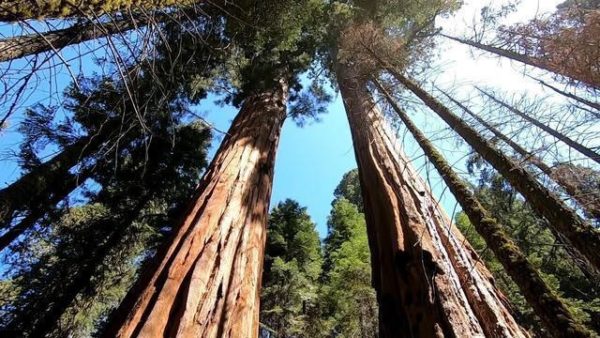
“Lazarus” is the name given to an iconic specimen of giant sequoia, in the Giant Forest located in Sequoia National Park. These magnificent trees can reach 300 feet (90 meters) during a lifespan that can exceed 3,000 years, and are famously resistant to droughts and fires. Lazarus,
more than 2,000 years old, is so called because it shows scars from surviving numerous severe fires.
But now, though the death of such a large creature is not an instant process, it appears to have expired.
“This is a tree that has lived through 2,000 years of fires, other droughts, wet years, dry years, hot years, cold years. It’s been here longer than Europeans have been in this country and it’s dead. And it shouldn’t be dead. This is not how giant sequoias die. It’s suppose to stand there for another 500 years with all its
needles on it, this quirky, persistent, impressive, amazing thing, and then fall over. It’s not supposed to have all of its needles fall off from the top to the bottom and then stand there like that. That’s not how giant sequoias die,” mourned Dr. Christy Brigham, who is responsible for the welfare of the ecosystems in Sequoia and Kings Canyon national parks.
The National Park Service will publish a study this year of 28 sequoia that have died since 2014, including Lazarus. But Kristen Shive, director of science for the Save the Redwoods League of San Francisco (which also monitors the related coastal redwood species), found far more in a survey of multiple groves: 53 in Black Mountain Grove (the “Black Mountain Beauty” tree, formerly the #11 giant sequoia for size, survives but with the loss of much of its volume), 33 in Nelder Grove, 14 in Lockwood Grove, 12 in Grant Grove.
The Rough Fire of 2015 and the Railroad and Pier Fires of 2017 caused this mass mortality, unlike previous fires. Black Mountain Grove partially burned in 2008, but without loss of sequoias, and there were fewer losses after the Pier Fire where the earlier fire had been. The groves were accustomed to periodic fires, but the ill-conceived practice of immediate fire suppression since the 1880s has caused many forests to accumulate dead wood and brush which intensifies fires when they do spread. Human carelessness also contributes to the frequency of fire: while the defective electrical equipment implicated in many 2019 fires was not the culprit here, only the Rough Fire was attributed to lightning while the other two were believed to be from campfires.
But the largest change has been the climate. A “super drought” in California from 2012 to 2017 killed millions of conifer trees, adding to the fuel for wildfires and leading to an explosion of bark beetles. Dr. Nathan Stephenson, a forest ecologist with the US Geological Survey, discovered in 2017 that beetle infestation is the mechanism of these recent “standing” sequoia deaths (as opposed to toppling over from weakened root systems, which is normal). The beetle species Phloeosinus punctatus is not invasive, like the Asian beetles which spread Dutch elm fungus and wiped out so many trees in the eastern US and Europe. It is native to the west, but sequoia only began to be susceptible to it after the latest round of drought and fire.
The last time dozens of sequoias died within a short period was after a massive fire in Mountain Home Grove which dendrochronology dates to the year 1297. This was in the middle of what Jared Diamond dubbed the “Great Drought” c. 1100-1400. The Wari and Tiwanaku empires in South America collapsed; Cahokia near modern St. Louis, once a town of 30,000 (the largest north of Mexico), was abruptly abandoned; and the Puebloan peoples of the Southwest contracted their range, no longer able to irrigate much of their territory (the name Anasazi for the ghost pueblos has been misunderstood to refer to a different people from the modern Puebloans, which they were not: some pueblos still remember which older sites used to be theirs).
This roughly coincides with the “Medieval Maximum” in Eurasia, when temperatures were higher than at any historic time until the late 20th century. That differed from the post-industrial period in a few ways: the climate changes were not as uniform across the globe; the buildup took over 2,000 years rather than under 200; and we have already passed the medieval peak and are still climbing. The die-off of giant sequoias is another sign that we’re entering an era unlike any in our previous history.
It is possible that the “Medieval Maximum” was also driven by human fuel-burning and land-clearing (at a less extreme pace), and that the “Little Ice Age” cooling cycle from c. 1400 to the bottom-out year 1816 (“Eighteen Hundred and Frozety Death” when a volcano added an extra blast of cooling) couldn’t have started without a mass die-off of humans. It should give us pause that the “Medieval Maximum” ended in Eurasia with the Black Death killing one-third of all people.
Robert Eckert is a longtime member of the Underground Bunker community and author of the historical novel The Year of Five Emperors.






